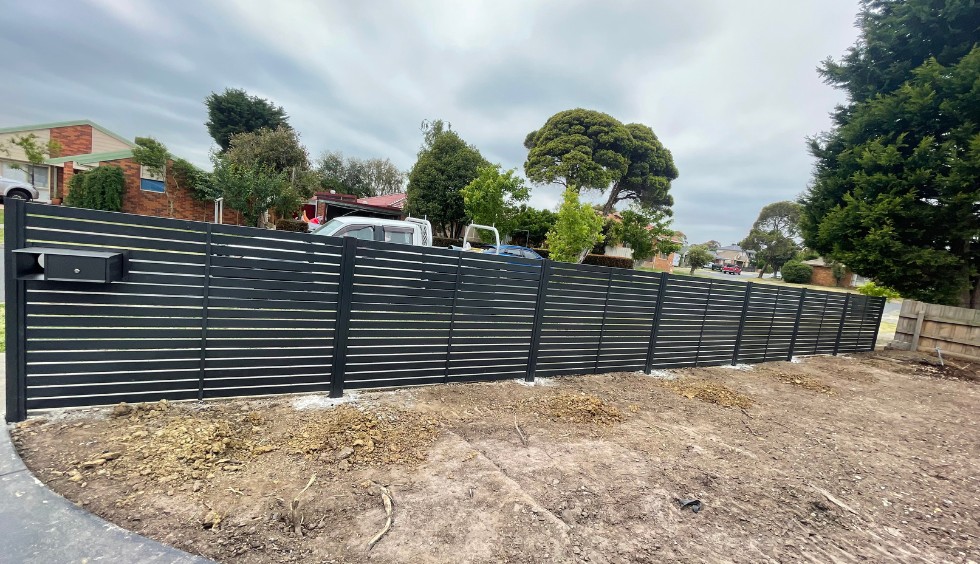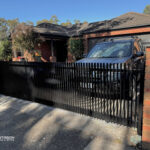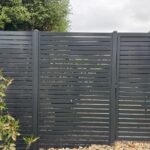Fencing plays a crucial role in defining the perimeter of your property while enhancing its aesthetic appeal and providing security. Among the myriad of fencing materials available in the market, aluminium and PVC are two popular choices. Both offer distinct advantages and drawbacks, making the decision between them a significant consideration for homeowners. In this comprehensive guide, we’ll delve into the characteristics, pros, and cons of aluminium fence and PVC fence to help you determine which option is the right fit for your needs.
Aluminium Fencing: Sleek, Strong, and Stylish

Characteristics: Aluminium fencing is crafted from lightweight yet durable aluminium alloy, making it an ideal choice for both residential and commercial applications. Available in a variety of styles, colours, and finishes, aluminium fencing offers versatility in design, allowing homeowners to tailor the appearance of their fences to suit their preferences and complement their property’s architecture.
Pros:
- Durability: Aluminium fencing is highly resistant to rust, corrosion, and weather damage, ensuring long-lasting performance even in harsh outdoor conditions. Unlike iron or steel fences, aluminium does not rust, making it an excellent choice for coastal or humid environments.
- Low Maintenance: One of the most significant advantages of aluminium fencing is its low maintenance requirements. Unlike wood fencing, which requires regular staining or painting, aluminium fences typically only need occasional cleaning with soap and water to maintain their appearance.
- Versatility: Aluminium fencing offers a wide range of styles, from traditional picket fences to modern aluminum slat fencing designs, providing homeowners with ample options to match their aesthetic preferences and enhance curb appeal.
- Ease of Installation: Aluminium fences are relatively easy to install, especially compared to materials like wrought iron or concrete. Many aluminium fence systems come with pre-assembled panels and simple installation instructions, making them suitable for DIY projects or professional installation.
Cons:
- Cost: While aluminium fencing is more affordable than wrought iron or steel alternatives, it tends to be more expensive than PVC fencing. The initial cost of aluminium fencing may deter some budget-conscious homeowners, although its durability and low maintenance can offset long-term expenses.
- Less Privacy: Depending on the style chosen, aluminium fencing may offer less privacy compared to solid materials like wood or vinyl. Open designs such as picket or ornamental fences allow visibility through the gaps between panels, which may not be suitable for homeowners seeking maximum privacy.
PVC Fencing: Durable, Low-Maintenance, and Versatile

Characteristics: PVC, or polyvinyl chloride, fencing is constructed from synthetic plastic polymer materials. Also known as vinyl fencing, PVC fences are renowned for their durability, longevity, and versatility. PVC fences come in a variety of styles, including privacy, semi-privacy, picket, and post-and-rail designs, catering to different aesthetic preferences and functional requirements.
Pros:
- Durability: PVC fencing is highly durable and resistant to rot, decay, insect infestations, and environmental elements such as moisture and UV exposure. Unlike wood fencing, PVC does not warp, crack, or splinter over time, ensuring a long lifespan with minimal maintenance.
- Low Maintenance: One of the most significant advantages of PVC fencing is its minimal maintenance requirements. Unlike wood fences that require regular staining, painting, or sealing, PVC fences only need occasional cleaning with soap and water to remove dirt and grime, maintaining their appearance for years to come.
- Versatility: PVC fencing offers a wide range of styles, colours, and textures, allowing homeowners to customize their fences to match their property’s aesthetics and enhance curb appeal. Whether you prefer the classic look of white picket fences or the modern appeal of sleek privacy panels, PVC fencing provides ample design options to suit your taste.
- Affordability: PVC fencing is often more affordable than other materials like aluminium, wrought iron, or natural wood. While the upfront cost may vary depending on the style and quality of the PVC fence, its long-term durability and low maintenance can result in cost savings over time.
Cons:
- Limited Colour Options: While PVC fencing offers a variety of colour choices, including white, tan, and grey, the selection may be more limited compared to aluminium fencing, which can be powder-coated in virtually any colour. Homeowners with specific colour preferences may find the options somewhat restrictive.
- Temperature Sensitivity: PVC fencing may expand and contract with temperature fluctuations, particularly in extreme hot or cold climates. While this rarely causes structural issues, it may affect the appearance and alignment of the fence over time.
Compare Aluminium Fence vs PVC Fence

1. Appearance
The appearance of a fence plays a pivotal role in defining the overall aesthetic of your property and harmonizing with its architectural style. Both aluminium and PVC fencing offer a diverse array of options to cater to various aesthetic preferences.
Aluminium fencing exudes a sleek and elegant appearance, often characterized by evenly spaced vertical pickets that create an open and airy ambiance. Its powder-coated finish ensures durability and minimal maintenance, while its customizable colour options allow for seamless integration with your design scheme. Additionally, aluminium fences can replicate the timeless appeal of traditional wrought iron, adding a classic touch to your property.
In contrast, PVC fences are celebrated for their versatility in style and design. Available in an extensive range of colours, textures, and patterns, PVC fences offer homeowners the flexibility to choose a fence that seamlessly blends with their surroundings. These fences can mimic the natural appearance of wood, providing a rustic charm without the associated upkeep. However, some individuals may find the synthetic look of vinyl less appealing compared to the sophisticated aesthetic of aluminium.
2. Cost
Cost is a significant consideration for many homeowners when selecting a fencing material. Finding the right balance between quality, durability, and affordability is crucial in making an informed decision.
Aluminium fencing typically commands a higher upfront cost compared to PVC. Factors such as the quality and thickness of the aluminium used, as well as any additional customization, influence the overall expense. Despite the initial investment, aluminium fences are often viewed as long-term assets due to their exceptional durability and low maintenance demands. Their resistance to rust, rot, and pests minimizes repair and replacement costs over time, making them a cost-effective choice in the long run.
On the other hand, PVC fencing tends to be more budget-friendly in terms of initial installation costs. However, it’s essential to consider the long-term expenses associated with vinyl. PVC fences may be vulnerable to damage from extreme weather conditions, potentially leading to warping, cracking, or fading. Although they require minimal maintenance, occasional cleaning and repairs may be necessary to preserve their appearance and structural integrity. Additionally, the lifespan of aluminium fences typically exceeds that of PVC, further contributing to their overall cost-effectiveness.
3. Durability
Durability is a paramount consideration for homeowners seeking a robust and long-lasting fencing solution. Both aluminium and PVC fences boast distinct characteristics that dictate their ability to withstand various environmental factors and external pressures.
Aluminium fences are renowned for their exceptional durability. Resistant to rust, corrosion, and insect damage, these fences maintain their structural integrity even in the face of harsh outdoor conditions. The powder-coated finish provides an additional layer of protection against fading and chipping, ensuring long-term resilience. Lightweight yet sturdy, aluminium fences can withstand strong winds and impacts without succumbing to warping or bending, making them a reliable choice for homeowners seeking durability and longevity.
PVC (Vinyl) fences, while generally durable, have certain considerations to bear in mind. Designed to resist cracking, peeling, and rotting, vinyl fences are well-suited for environments with high humidity or moisture. However, extreme temperatures can affect their performance, potentially leading to expansion and contraction that may result in warping or sagging. Additionally, some PVC fences may be susceptible to damage from impacts, necessitating careful selection of high-quality materials to ensure optimal durability.
4. Maintenance
The level of maintenance required for a fence significantly impacts its long-term appeal and cost-effectiveness. Homeowners often seek fencing materials that are easy to maintain, allowing them to enjoy their property without dedicating excessive time and effort to upkeep.
Aluminium fences are virtually maintenance-free. With no need for painting or staining, these fences require only occasional cleaning with mild soap and water to keep them looking pristine. Resistant to pests and rot, aluminium fences eliminate the need for regular inspections or repairs, offering homeowners convenience and peace of mind.
PVC fences also boast low maintenance requirements. Their smooth surface facilitates easy cleaning with water and mild detergent, ensuring that dirt and grime can be effortlessly removed. However, PVC fences may accumulate mold or mildew over time, particularly in humid climates or shaded areas. Regular cleaning is essential to prevent such buildup and maintain the fence’s appearance. Prompt repairs should also be carried out in the event of any damage to prevent further deterioration. While the maintenance demands for vinyl fences are generally minimal, they may require slightly more attention compared to aluminium fences.
5. Environmental Impact
Considering the environmental impact of your fencing choice is vital for those committed to eco-friendly practices. Understanding the sustainability and recyclability of the materials used can help reduce your carbon footprint and contribute to a greener future.
Aluminium stands out as a highly sustainable material. With one of the highest recycling rates globally, aluminium fences can be crafted from recycled aluminium, reducing the demand for raw materials and minimizing energy consumption during production. Furthermore, the longevity of aluminium fences reduces the need for frequent replacements, contributing to waste reduction and environmental preservation.
PVC fences present a more complex environmental picture. While PVC itself is not biodegradable, some manufacturers produce vinyl fences using recycled materials, alleviating the environmental strain associated with vinyl production. However, the recycling process for vinyl is relatively limited, and the disposal of PVC fences at the end of their lifespan can pose challenges. Despite these considerations, advancements in vinyl recycling technologies offer promise for future improvements in sustainability.
Making the Decision: Factors to Consider

Aluminum Vertical Blade Fencing
Choosing between aluminium and PVC fencing requires careful consideration of several factors, including:
- Budget: Determine your budget for fencing installation and maintenance, considering both upfront costs and long-term expenses. While PVC fencing is generally more affordable upfront, aluminium fencing may offer better durability and longevity, potentially resulting in lower overall costs over time.
- Aesthetic Preferences: Consider the architectural style of your home, your landscaping, and your personal taste when selecting a fencing material. Both aluminium and PVC fencing offer a variety of styles, colours, and finishes to complement different design aesthetics.
- Maintenance Requirements: Evaluate your willingness to perform regular maintenance tasks, such as cleaning, painting, or repairs. While aluminium and PVC fencing are both low-maintenance options, aluminium may require less upkeep over time due to its resistance to rust and corrosion.
- Functional Needs: Determine the primary purpose of your fence, whether it’s to provide security, privacy, or decorative enhancement. Certain styles of fencing, such as PVC privacy panels or aluminium ornamental designs, may better suit specific functional requirements.
Conclusion
When it comes to choosing between aluminium and PVC fencing, there is no one-size-fits-all solution. Each material offers distinct advantages and drawbacks, depending on factors such as durability, maintenance requirements, aesthetics, and budget. Ultimately, the right choice for you will depend on your unique preferences, priorities, and practical considerations. Whether you opt for the sleek, modern appeal of aluminium fencing or the timeless durability of PVC, investing in quality fencing can enhance your property’s appearance, security, and value for years to come.
Reach Out to The Best Fencing Contractor in Melbourne
For top-notch fencing solutions in Melbourne, look no further than Pentagon Fencing & Gates. Specializing in aluminium and PVC fencing installations, we have earned a stellar reputation for excellence and customer satisfaction, offering a diverse array of options to elevate the security, privacy, and visual appeal of residential and commercial properties alike.
If you’re unsure about your fencing choices, feel free to get in touch with our team. We’re here to assist you in identifying the ideal fence material for your property, providing guidance on the quantity of fencing needed, and offering support throughout the installation process.
Explore our gallery to view actual projects showcasing our proficiency in landscaping your yard or home, enriching both security and visual appeal.




